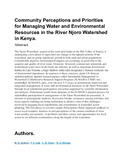| dc.description.abstract | The Njoro Watershed, typical of the semi-arid basins in the Rift Valley of Kenya, is undergoing a new phase of rapid land use change in the uplands portion of the watershed, and on-going significant growth in both rural and urban populations. Considerable negative environmental impacts are occurring, in particular to the quantity and quality of river water. Domestic, livestock, commercial, industrial, and institutional water users in the basin are affected, as well as important downstream habitat in Lake Nakuru, a large shallow saline lake designated a Ramsar wetlands site of international importance. In response to these concerns, ajoint US-Kenyan multidisciplinary applied research project called Sustainable Management of Watersheds Collaborative Research Support Program (SUMAWA-CRSP) was established. SUMAWA aims, over the next 3–5 years, to demonstrate improved and integrated management of water and environmental resources in the Njoro Watershed through local stakeholder participation and action supported by scientific information and analyses. Preliminary results from elements of the SUMAWA planned process for stakeholder participation in management of the Njoro Watershed are presented. A mixture of participatory methods, discussion forums, awareness-raising activities, and local capacity building are being undertaken to address some of the challenges involved in engaging local stakeholders and communities in watershed action planning. The first phase of activities adapts Participatory Rural Appraisal methods to assess local residents' interests in and perceptions of the current condition of river water quality and quantity, of problems and their causes, and opportunities for local action in six different communities along the length of the watershed. | en_US |
| dc.subject | Community, Perceptions, Priorities, Managing, Water, Environmental, Resources, River Njoro ,Watershed | en_US |

